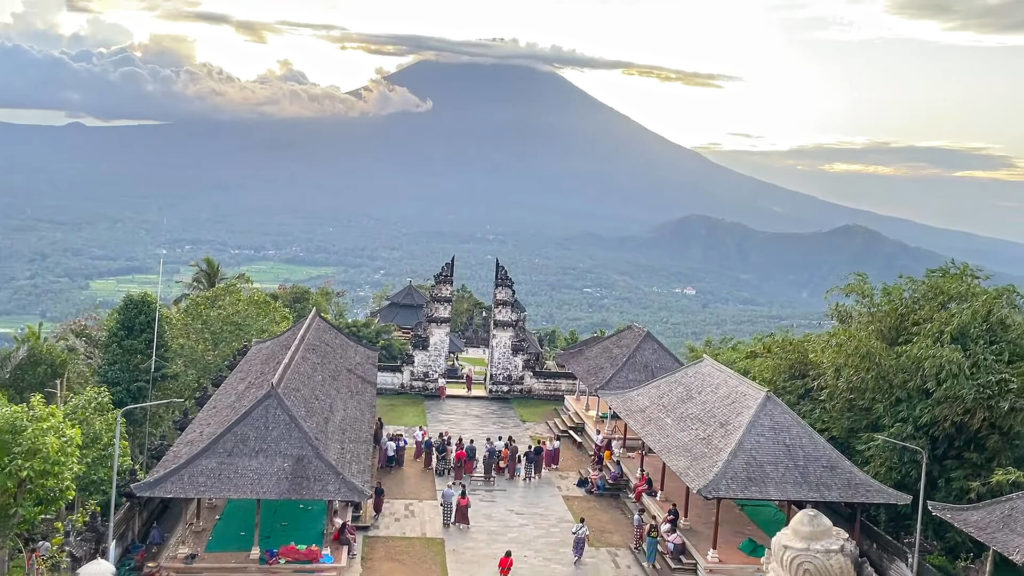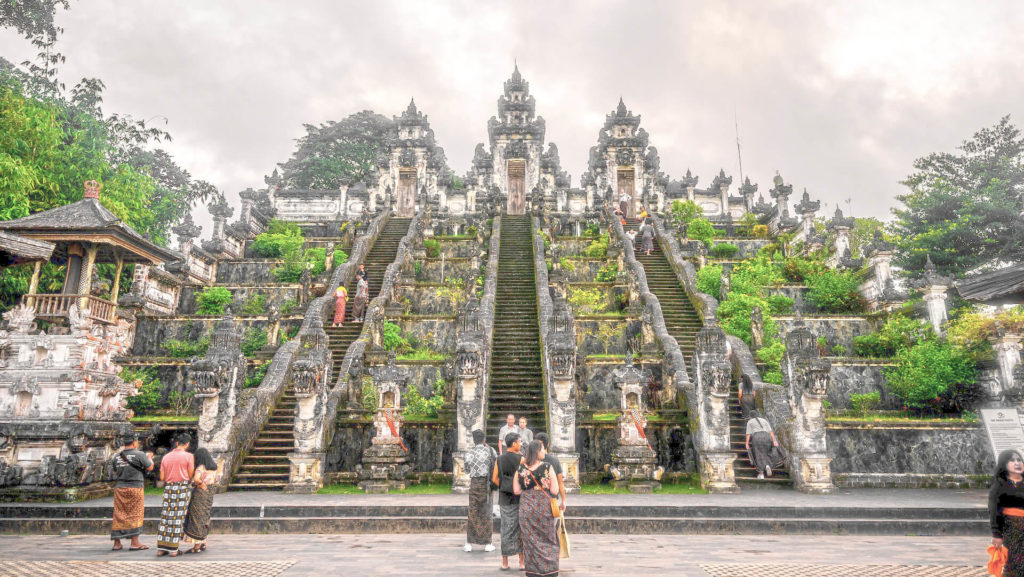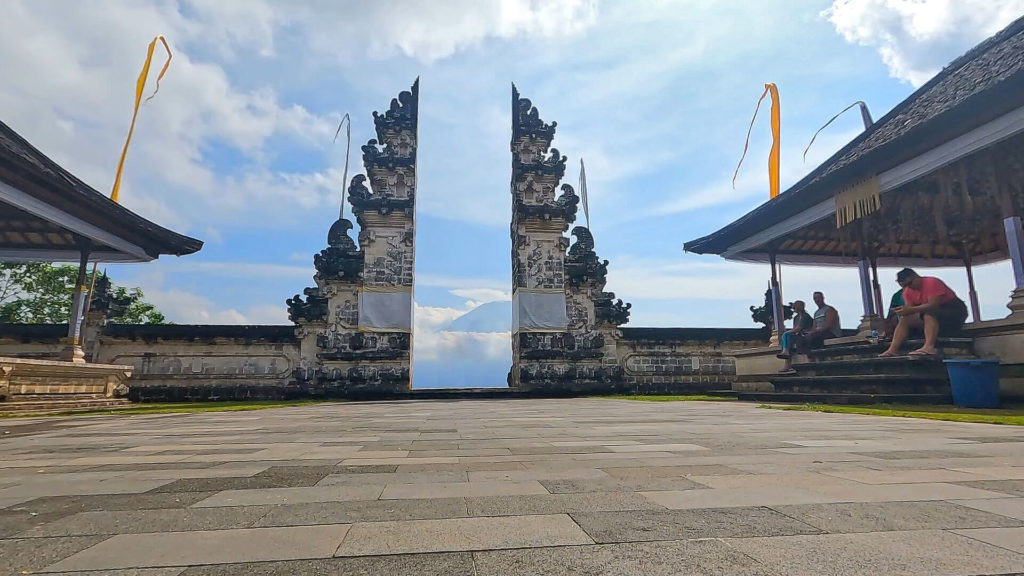Bali Gates Of Heaven & Lempuyang Temple

Welcome to the enchanting world of Lempuyang Temple, a place that has captivated the hearts of travelers and Instagram enthusiasts alike. Nestled in the highlands of Mount Lempuyang, this temple offers breathtaking views of Mount Agung, Bali’s most active volcano, shrouded in ethereal white clouds. Known as the “Gates of Heaven,” the temple’s elegant entrance gates are adorned with intricate carvings dedicated to the Hindu gods. While Lempuyang Temple has gained popularity as a must-visit destination, it’s important to delve deeper into its history and practical information before embarking on this spiritual journey.
Table of Contents
Lempuyang Temple History: A Place of Gods
Lempuyang Temple, also known as Pura Penataran Agung Lempuyang, is one of the six main temples of Sad Kahyangan Jagad, which are considered the pillars of Bali. These sacred temples, including Pura Besakih, Pura Gua Lawah, Pura Batukaru, Pura Pusering Jagat, and Pura Uluwatu, play a crucial role in maintaining the spiritual balance of the island. The word “Sad” translates to “six” in Sanskrit, and “Kahyangan” means “place of Gods.” Hence, “Sad Kahyangan” can be interpreted as the “six places of Gods.”
Built in the year 91 AD, Lempuyang Temple predates most other temples on the island, making it a revered site for Balinese Hindus. It is believed that every Balinese Hindu should visit this temple at least once every decade to fulfill their religious obligations. The temple is strategically located at an elevation of 600 meters (2,000 ft) above sea level, offering mesmerizing views of the surrounding forest and mountains. Its architectural beauty and serene ambiance rival that of famous temples like Tanah Lot and Uluwatu.
The establishment of temples around Mount Lempuyang predates the majority of Hindu temples on the island of Bali. The temple complex, consisting of seven different sanctuaries, is part of the Pura Sad Kahyangan Luhur Lempuyang, representing the “six sanctuaries of the world.” Balinese beliefs hold that these temple groups are pivotal points on the island, providing spiritual balance.
Lempuyang Temple Map Location: A Serene Retreat
Pura Lempuyang Temple is located in Banjar Purwa Ayu, Tribuana village, Abang Subdistrict, Karangasem regency, Bali, Indonesia. Situated atop Bisbis Hill in Mount Lempuyang, the temple complex offers a serene retreat at an elevation of 1,175 meters above sea level. The journey to the temple takes you through winding roads and picturesque landscapes. Mount Lempuyang, also known as Mount Lempuyang Luhur, is considered one of the most sacred natural points in Bali. It is approximately 22 km north of the city of Amlapura, and the route takes you through Tirtagangga and the village of Ngis in Abang sub-district before reaching the village of Purahayu.
How to Get to Lempuyang Temple: Embarking on a Spiritual Journey
Pura Lempuyang Temple is easily accessible from various areas of Bali. If you are arriving at Denpasar Ngurah Rai International Airport, the temple is approximately 89 km away, a car journey of about 2 hours and 45 minutes via Jl. Prof. Dr. Ida Bagus Mantra. Visitors staying in Nusa Dua, Jimbaran, Kuta, and Seminyak should allocate 2 to 3 hours for the journey, depending on traffic conditions. If you are coming from Ubud, the drive will take approximately 2 hours and 30 minutes via Jl. Prof. Dr. Ida Bagus Mantra.
It is important to note that there is no public transportation directly to Pura Lempuyang Temple. To make the most of your visit and explore other popular destinations in East Bali, we recommend hiring a car with a driver. This will allow you to immerse yourself in the beauty of the region and discover nearby attractions such as Tirta Gangga, Taman Ujung Water Palace, and Candidasa.

Self-driving a Scooter
For those seeking an adventurous experience, renting a scooter is a popular choice. Scooter rentals are available through accommodations or tour agencies, and prices are generally affordable, with an average cost of 70,000 IDR per day. It’s important to note that driving a scooter in Bali requires confidence and experience, as the roads can be challenging, especially during the ascent to Lempuyang Temple. However, if you’re an experienced scooter rider and up for the adventure, this mode of transportation can provide a thrilling journey with the flexibility to explore other attractions along the way.
Taxi Tour
If you prefer a hassle-free journey without the need to navigate Bali’s roads, a taxi tour is a convenient option. While it may be more expensive than self-driving, it offers the comfort of having a dedicated driver who can take you directly to Lempuyang Temple and other attractions in the area. If you’re traveling solo, consider joining a tour group or connecting with fellow travelers at hostels to share the cost of a private car and driver. Opting for a full-day tour allows you to visit multiple destinations and customize your itinerary according to your preferences.
Distances to Lempuyang Temple
- From Denpasar: About 83 kilometers (around 52 miles), and it typically takes 2-3 hours by car.
- From Ubud: Approximately 71 kilometers (around 44 miles), with a drive time around 2-2.5 hours.
- From Kuta: Roughly 90 kilometers (about 56 miles), generally a 2.5-3 hour drive.
- From Seminyak: About 88 kilometers (around 55 miles), typically a 2.5-3 hour drive.
- From Sanur: Approximately 80 kilometers (about 50 miles), generally a 2-2.5 hour drive.
- From Nusa Dua: Roughly 92 kilometers (around 57 miles), with a drive time around 2.5-3 hours.
Lempuyang Temple Entrance Fee: A Symbolic Donation
Visiting Pura Lempuyang Temple does not require an entrance fee. However, it is customary to make a small donation to the local villagers who maintain and clean the temple complex. As you explore the temple, it is essential to show respect at all times. Ensure that you are appropriately dressed, wearing a sarong, and covering your knees and shoulders. This dress code applies to both men and women. Additionally, if there is a ceremony taking place, it is best to maintain a respectful distance while taking photographs.
What to Expect at Lempuyang Temple: The Gateway to Heaven
On the slopes of Mount Lempuyang stands Pura Lempuyang Luhur, also known as Lempuyang Temple. This temple, with its iconic “Gates of Heaven,” is one of the nine directional temples on the island of Bali. The temple complex consists of two sections: a lower level and an upper level. While both sections offer unique experiences, the upper level is particularly renowned for its panoramic views and the famous “Gateway to Heaven.”
As you enter the temple complex, you will be greeted by a picturesque landscape with Mount Agung in the background. The surrounding forest, known as the lungs of Bali, adds to the tranquility of the setting. To reach the main temple, visitors must climb more than 1,500 steps, a journey that takes approximately three hours. Along the way, you will be captivated by the stunning scenery and enjoy the refreshing cool air of the forest. Despite passing through clouds, you will find that your clothes remain dry – a unique phenomenon experienced by many visitors.
One of the intriguing features of Pura Luhur Lempuyang is a Pelinggih named Tirta Pingit (Secret). This sacred area is nestled among bamboo groves, with only three clusters of bamboo growing in this particular spot. The Pemangku (Priest) of Pura Tirta Lempuyang Luhur collects holy water, known as Tirta, from these bamboo clusters. Visitors, both those participating in ceremonies and tourists, have the opportunity to receive this holy water. The bamboo miraculously continues to grow despite being frequently cut for the collection of Tirta.
Dress Code and Etiquette
To show respect to the religious significance of Lempuyang Temple, visitors are required to adhere to a dress code. Both men and women should wear a sarong, which can be rented at the temple entrance for a nominal fee of around 10,000 IDR. The sarong should cover your legs, and it is recommended to wear a t-shirt or blouse that covers your shoulders. These guidelines apply to all visitors, regardless of gender. Public displays of affection are considered inappropriate, and visitors are advised to refrain from engaging in such behavior while on the temple grounds. Additionally, individuals who are menstruating or have open wounds are not allowed to enter the temple site, as per religious customs. Lastly, it’s important to note that drones are prohibited within the temple premises.
Lempuyang Temple Opening Hours: A Spiritual Journey Day and Night
Pura Lempuyang Temple welcomes visitors daily from 09.00 AM to 06.00 PM. However, for worship purposes, the temple remains open 24 hours a day. The unique location of the temple, along with its breathtaking views, attracts visitors who are willing to embark on the steep and challenging climb. With over 1,700 stairs leading to the temple at an elevation of 1,200 meters above sea level, this journey offers a combination of adventure, panoramic views, and a glimpse into ancient religious traditions.
Best Time to Visit Lempuyang Temple
To make the most of your visit to Lempuyang Temple, it’s essential to consider the best time of the year and day to experience its beauty and tranquility. Bali’s dry season, which runs from April to October, is generally considered the ideal time to visit Lempuyang Temple. During this period, the weather is relatively dry, and clear skies offer splendid views of Mount Agung, creating a picturesque backdrop for your visit. However, do keep in mind that weather conditions can be unpredictable, and even during the dry season, there may be days with cloudy or overcast skies.
To avoid the crowds and extreme heat, it is advisable to visit Lempuyang Temple early in the morning or late in the day. If you’re an early riser, watching the sunrise at the temple can be a magical experience, as the soft golden light illuminates the landscape. Alternatively, visiting during the golden hour before sunset can provide a serene atmosphere and stunning photo opportunities. Arriving early also allows you to beat the rush of visitors, especially if you’re keen on capturing the iconic shots at the Gates of Heaven.
Lempuyang Temple Layout: A Journey through Sacred Spaces
Lempuyang Temple, or Pura Penataran Agung, is located on the slope of Mount Lempuyang, approximately 600 meters above sea level. The mountain is divided into three sections, each corresponding to a different aspect of Balinese cosmology. The base of the mountain, known as Sang Ananta Bhoga, represents the mount of Brahma. The middle part, Sang Naga Basukih, corresponds to the mount of Vishnu. Finally, the top of the mountain, Sang Naga Taksaka, is considered the mount of Shiva. The most sacred point of Mount Lempuyang is where Pura Lempuyang Luhur is situated.
The temple compound is divided into three areas: the outer sanctum (jaba pisan or nistaning mandala), the middle sanctum (Jaba Tengah or Madya Mandala), and the inner main sanctum (Jero or Utamaning Mandala). The entrance to the outer sanctum is marked by a white-painted candi bentar split gate. Within this area, you will find several bale (Balinese pavilions), including the rectangular bale gong, where the gamelans are stored, and the bale kulkul, which houses the percussive drum used for calling prayer.
To enter the middle sanctum, you will pass through three white-painted paduraksa portals. The central portal is only opened during the temple’s main festivals, such as the biannual piodalan festival. Mythical Naga figures flank the stairs leading to the portals, and sculptures inspired by the epic Ramayana adorn the landscape. At the highest level, you will find the statue of Krishna, the worldly form of Vishnu. The innermost sanctum, Jero, is the most sacred courtyard of the temple and features meru towers and pelinggih shrines dedicated to different gods and deities.
Lempuyang Temple Hike: A Journey to the Sacred Summit
For those seeking an even more profound experience, a hike to the summit of Mount Lempuyang is highly recommended. Pura Lempuyang Luhur, the highest temple in the complex, sits majestically atop the mountain peak, believed to be the most sacred spot. The journey to the summit involves climbing over 1,700 stairs, a challenging but rewarding trek. As you ascend, you will pass through small remote villages, providing a glimpse into the authentic Balinese way of life. Once you reach the temple, you will be greeted by a handful of fellow adventurers and receive warm hospitality from the guides and priests.
Things to Know Before Visiting Lempuyang Temple: Respect and Reverence
As with any temple visit in Bali, it is essential to be aware of certain customs and practices to show respect to the Balinese people and their religious traditions. Here are some important things to keep in mind before visiting Pura Lempuyang Temple:
- Dress Code: Both men and women should wear a sarong and ensure that their knees and shoulders are covered. This dress code is a sign of respect when entering the temple complex.
- Public Displays of Affection: Pura Lempuyang Temple is a place of worship, and any form of kissing or intimate behavior in public is seen as inappropriate and scandalous.
- Photography Etiquette: While photography is allowed, be mindful of the worshippers and avoid taking photos directly in front of them. Maintain a respectful distance and use zoom lenses when necessary.
- Offerings: Take care not to step over or tread on offerings left on the ground. These small offerings, called canang sari, are meant to appease the spirits, and it is crucial to be mindful of where you are walking.
- Menstruation and Wounds: Women who are menstruating or anyone with a running sore or bleeding wound should not enter any Balinese temple, as they are considered impure during these times.
- Respectful Behavior: Above all, remember that the temple is a space of reverence. Treat it with utmost respect, and your visit will bring you the happiness and enlightenment you seek.
Unveiling the Gates of Heaven
One of the main attractions at Lempuyang Temple is the famous Gates of Heaven. These majestic entrance gates, also known as “candi bentar,” serve as a symbolic gateway connecting the earthly realm to the spiritual realm of the temple compound. The Gates of Heaven draw inspiration from Mount Meru, a mythical golden mountain believed to be the center of the universe in Hindu cosmology. As you stand in front of these gates, you’ll be mesmerized by their intricate carvings and the sense of awe they evoke.

The Illusion of the Gates of Heaven
It’s important to note that the stunning photos you may have seen of the Gates of Heaven on social media are often enhanced through photo trickery. A dedicated team works behind the scenes to create the illusion of a reflection pool in the foreground. In reality, there is no actual pool of water at the temple entrance. To achieve the mirror-like reflection effect, a team member strategically positions a mirror halfway across the camera lens while capturing the shot. This technique creates a stunning visual deception, giving the illusion of a perfectly balanced reflection. While it may come as a surprise, this knowledge allows visitors to appreciate the artistry and creativity behind these captivating photographs.
Tips for Capturing the Perfect Shot
If you decide to have your photo taken at the Gates of Heaven, it is recommended to hand over your smartphone to the photo team, even if you have a high-quality camera. The team members are skilled in operating various smartphone models and can ensure the best results with the mirror technique. However, it’s worth noting that this technique may not work as effectively with professional cameras, as the shots may appear overexposed or lacking the desired reflection effect. To make the most of your photo opportunity, it is advisable to decide on your poses in advance, as there is limited time available for each visitor. The photo team will announce the number of poses allowed, typically limited to three per person or group. By arriving early before the official opening time of 7 am, you can increase your chances of capturing stunning photos without the crowds.
